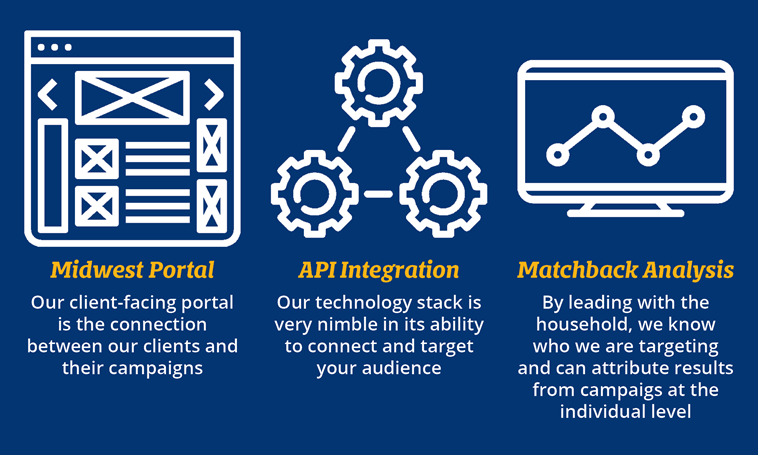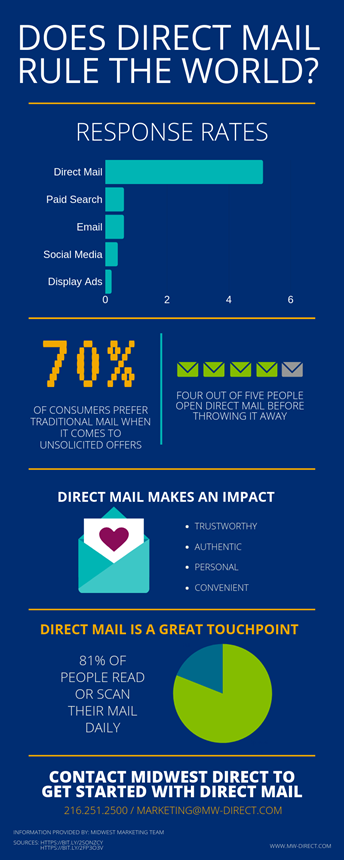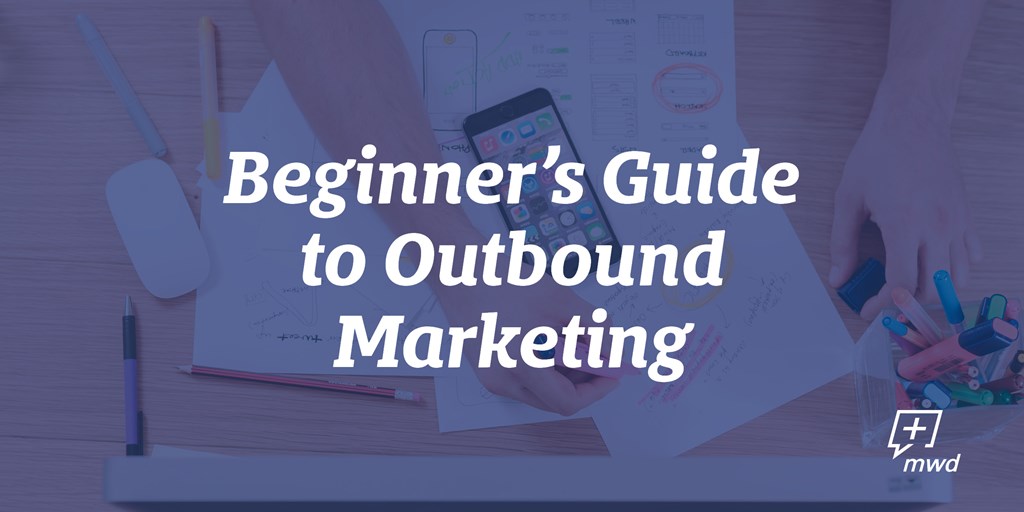Why Outbound Marketing?
Print/mail is the outbound channel currently with the highest response channel. When you start with a solid list, send highly targeted print through the mail and integrate email, social media and/or online advertising, you’re likely to experience campaign lift in all channels.
What’s the most important thing in marketing? Capturing leads that end with conversions. Everything you’re about to read points to the ultimate goal -- conversions. Depending on your business that may mean sales or members or donations. Whatever conversion you need to grow your business is the ultimate goal of your marketing efforts. Everything you do with your marketing spend should have a direct impact on your bottom line and your job as a marketer is to be able to prove it.
This guide will focus on outbound marketing and the methods you can use to integrate inbound channels with your outbound efforts.
AND Outbound Marketing Includes Much More Than Print
Why outbound? Because print/mail is the outbound channel currently with the highest response channel. When you start with a solid list (see our Data section), send highly targeted print through the mail and integrate email, social media and/or online advertising you’re likely to experience campaign lift in all channels. Here are some new outbound tools to add to your toolbox.
Informed Delivery®
Informed Delivery® is a new email channel offered by the USPS®. Over 18 million people have already opted-in to receive this daily email that enjoys a 60% open rate! The email contains grey-scale scans of the mail to be delivered to the home on that day. Here’s the good news -- the USPS® allows marketers to upload a full-color image of the mail to replace the grey-scale scan -- and you can add a link with an offer to your landing page. This has a big impact on engagement with your mail piece and adds an additional channel and touchpoint to your campaign. Learn More about Informed Delivery.
Revolutionize Direct Mail with Integrated Marketing Solutions
You can now send online display ads to the same homes you want to mail and they are guaranteed to be on view. You can use your list to place ads on the Facebook and Instagram feeds of your audience — also guaranteed to be seen. You can identify leads that enter your site and target them with online ads and on social media. That’s a lot of advertising power that is relatively new in direct marketing. If you want to learn more about this NEW offering give us a call and ask about digital+post.
Retargeting with Display Ads and Mail

Display ads are generally considered paid media and part of the inbound strategy. Retargeting with traditional display ads takes place when your targeted demographic arrives on a website/app with content that is relevant to your ad. Retargeted display ads are served to anyone who triggers the contextual appearance of your ad and you can send a postcard to their home. The target is then “inbound” when they click on the ad, hit the landing page listed on the mail piece, call the number provided, etc. Although things have improved dramatically over the last couple of years with contextual search, there is still much room for improvement concerning ad fraud and bot traffic. Learn more about retargeting with display ads and mail.
Outbound Marketing
Your audience wants to engage with you -- and they want to do it online, on their phone or in their mailbox. Are you giving them the customer experience they want? Are you capturing and converting your best leads? Can you prove your marketing efforts and money spent resulted in sales?
If you’re new to Outbound Marketing, we’ve boiled this down to a few key steps to get you on the path to successful campaigns that drive sales.
Outbound Marketing: What To Do
There are just a few key elements to any marketing effort that will determine the outcome and they are: List, Offer, Creative, Distribution, Reports, and Recommendations. Once you’ve mastered each of those, you’ll find your organization’s marketing sweet spot to drive engagement, conversions, and sales!
We’ll get you there in 5 simple steps:
- List: Get the best possible list you can for your campaign. If you’re using historical data, make sure it’s clean, updated and, if you can, enhanced with emails, IP addresses, and social media accounts. If you don’t know how to access those additional data points, ask a reputable data service provider. Then segment your list for personalization and check your list for accurate mail and email addresses.
- Offer: Make sure you’ve got a good incentive or offer to motivate your audience to act. How do you know for sure what will motivate them? Test your ideas! The offer is the most frequently tested element in marketing. Pull out some records for an A/B split test, and if you need help, ask for it. It’s well worth the effort to test your campaign offers so you can adjust as needed and for future business intelligence.
- Creative: The look of the campaign and all the touchpoints should be cohesive, complementary and consistent with your brand. If you’re starting out, don’t get wild and crazy. Keep it simple and err on the side of caution. IF you have the budget to test two or more versions of creative, then you can add in something more adventurous. If you need help, ask us or your favorite graphic designer for feedback. Someone with creative experience and preferably with experience designing in your industry.

- Distribution: It’s time to plug all of the elements in this blog into the right channels and start distribution. Map out your campaign touches, channels, and timelines for print/mail, email and/or online ads. Be sure to include ALL the production schedules required to get to distribution. If this is a lot to manage, you can opt for the help of a reputable marketing services provider to integrate your vertical efforts into one campaign timeline with integrated messages and reports. We offer our accounts a dashboard that shows mail tracking, Informed Delivery email tracking and results, Social Media (FB, Insta) publication and results, etc.
- Reports and Recommendations: Once you’ve distributed your messages, you can begin to pull the reports and formulate recommendations to repeat or improve your next campaign. Solid analysis of those results is critical to future success, so make sure you look at all the data and match back your engagement and conversion events to actual reported sales. It can be difficult to get that data to match up for easy analysis. If you need help, ask the Data team at Midwest Direct to help you get to your most important business intelligence. They make it look easy and can offer knowledgeable insight into your results.
Data
We like to see that every campaign begins and ends with data. The only question is what quality data do you have to launch your campaign? That will greatly influence your campaign results and the data you get back. Outbound channels rely heavily on good data as your campaigns are direct marketing efforts -- meaning you will send your email, printed mail, online ads to the people on your list -- so make sure it’s good!

Data: What To Do
The way you set up your database and the maintenance of the accuracy of that data is the foundation of any excellent marketing effort. Make sure you follow these rules -- or get some help from our data team to do so.
1. If your data (or databases) aren’t perfect, you can work with that.
- Files can be formatted to create uniform data, match records and reveal bad data which can include multiple addresses, incorrect names, mismatched fields, etc.
- Bad or multiple addresses can be updated to the most recent address.
- Deceased records can be easily culled
- Records are required to be run through National Change of Address (NCOA) for regular updates to correct the addresses of people already in your database that have moved.
- Demographic data can be added to existing contacts to make your marketing more relevant
- Contacts without emails or IP addresses (for online, in-home advertising can be addressed) can be added.
2. Always start with the end in mind. Collect data that will help you market better and can be used later to segment marketing messages, create customer profiles and journeys and tie-back your marketing efforts with your sales results.
See our Beginner’s Guide on Data for more information.
There’s no reason to shy away from print and mail -- even if you don’t have experience creating a mailer. There are many designers, printers or mailers who can help you develop the content. You can learn on your own (see Other Resources at the end for more information) or consult with a professional printer or mailer for creative services. After that, there are a few simple steps involved in completing a print/mail piece.
Print: What to Do
- Be sure what you plan to mail is qualified to mail at the rate you expect. Whether you plan to send it as Marketing Mail or First Class Mail, you’ll need to know the right size, weight, and timelines. Call a mailing professional for help or check out our blog First Class vs. Standard Mail (Marketing Mail).
- Determine your quantity. This will be the amount of records on your list, plus however many “extras” you need for handing out, keeping on file, showing off to friends and family, etc…
- Figure out the dimensions of your piece. Again, work closely with your mailing professional as sizes will affect your print and mail price. Common print sizes include 8.5" x 11"(considered “standard” sized paper), 8.5" x 5.5"(a traditional postcard size), a “self-mailer” (piece that can be mailed without an envelope), #10 envelopes (4 1/8" by 9 1/2", holds a standard-sized sheet folded into thirds) and #9 reply envelopes (8 7/8"x 3 7/8", often found enclosed with statements). Need help? Read our blog to learn how to Prep For Your First Print Project Like a Pro.
- Determine the type of print you want. Four-color or Litho print is high-quality, the gold standard for color control and paper selections, but will cost significantly more than digital print. If your designer has specced a “spot color” you’ll have no choice but to buy litho print. So, ask lots of questions in advance and for a quote of your job built both ways. Your designer can then help you weigh the pros and cons. While you’re at it, ask the designer to show you a piece with bleeds and without bleeds. This refers to how closely the artwork goes to the edge of the paper and will change the look and price of your piece.
- Select your paper stock. Here are some of your options: Paper can either be coated or uncoated. Coated: Includes gloss, matte, and semi-gloss. Uncoated: Looks like what normal copy paper would look like, without any type of shine or matte finish. When it comes to paper weight, there are two main categories: text weight and cover weight. Comparing the two categories is easier if you have an example of a book in mind, with the inside pages being text weight, and the thick outside being the cover weight. Text weight can be broken down into two additional categories: copy paper (which is exactly what it sounds like: the typical paper you used to print something at work) and offset (similar to copy paper, but with a slightly thicker and higher quality). Most projects will end up being a combination of both text and cover weight, with different coating options as well. The size of the sheet, as well as budget, will affect what combinations you choose.
Got all that? We know the technical side of printing can be overwhelming. If you’re feeling like you’re in over your head, call us. We’ll help you get through these tough choices with confidence!
Have you ever put a letter in an envelope, affixed a stamp then dropped it in the mail? In many ways, getting a major mailing out is still -- in the end -- about that easy. If you work closely with a mailing services provider (MSP) you can keep it simple.

Mail: What to Do
Let’s break it down:
- You need the name and address of every piece of mail, which means you need a list of those with all the information corrected, no duplicates and the right business rules in place. If you’re not a mailing expert, it’s well worth it to speak with your MSP first, they can help you save time and money on your mailing.
- You need the postage. Depending upon what class your piece will mail and your piece itself (dimensions, weight, etc.) your postage price will vary. Work with your MSP to ensure you’re getting the best price.
- Choose the right MSP for your business. Here’s a little help with that. You can also contact us anytime! We’re mailing professionals and are willing to help you get started with this great direct marketing channel!
Other Sources
You don’t have to take our word on all that great info you just learned! Here are a few resources we’d like to share. When you understand this marketing universe better, you can run your marketing and communications campaigns with better engagements and results.
Data+
Print/Mail+
How to Do Layout Design for Print
Business Mail 101: Learn the Basics of Business Mail
Want more? You can have it! Get more information on Data, Print/Mail and Marketing on our website or contact us to learn more.
Tracking, Reporting, and Analytics -- a sneak preview...
We will save the deep dive on these topics for our post on the Beginner’s Guide to Marketing Data and Analytics, but here’s a quick overview.
Once you’ve launched your campaign, you’ll have all kinds of data -- mail tracking, online click-through rates, impressions, etc. All that is great, but it doesn’t mean much if you can’t figure out if your efforts drove sales. With the new tracking technology, you can see WHO came to you from email, mail and online display ads, but — and this is critical — you have to know how to set that up to capture the leads before you launch. See our future publication, Beginner’s Guide to Marketing Data and Analytics to learn how to master this powerful approach. (Sign up at the bottom of the page to receive it by email when released.)
